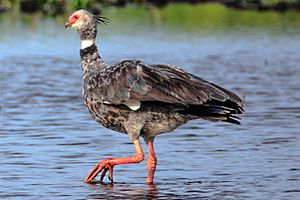Screamer facts for kids
Quick facts for kids Screamer |
|
|---|---|
 |
|
| Southern screamer (Chauna torquata) | |
| Scientific classification |
|
| Kingdom: | Animalia |
| Phylum: | Chordata |
| Class: | Aves |
| Order: | Anseriformes |
| Suborder: | Anhimae Wetmore & Miller 1926 |
| Family: | Anhimidae Stejneger, 1885 |
| Genera | |
|
|
The screamers are three types of large, noisy birds that live in South America. They belong to a special bird family called Anhimidae. Even though they look a bit like chickens (called Galliformes) because of their bills, screamers are actually more closely related to ducks. Their closest relative is the magpie goose.
One unique thing about screamers is that their ribs don't have certain hooks called "uncinate processes," which most other birds have. The three species of screamers are: the horned screamer (Anhima cornuta), the southern screamer (Chauna torquata), and the northern screamer (Chauna chavaria).
Contents
Screamer Family Tree and History
Scientists don't have many fossils of screamers, so their ancient history is a bit of a mystery. We know of a very old screamer relative called Chaunoides antiquus from millions of years ago in Brazil.
Screamers are most similar to a group of ancient birds called presbyornithids. It's possible that screamers evolved from birds like these. They might have even changed from eating by filtering water to eating plants.
| Image | Genus | Living Species |
|---|---|---|
 |
Anhima |
|
 |
Chauna |
|
Where Screamers Live and What They Look Like
All three screamer species live only in South America. You can find them from Colombia all the way down to northern Argentina. The horned screamer used to live on the Caribbean island of Trinidad, but it's not there anymore.
Screamers are big, heavy birds. They have small, fluffy heads, long legs, and large feet. Their feet are only partly webbed. They also have large, sharp spurs on their wings. They use these spurs when they fight over mates or their territory. These spurs can break off, but new ones grow back regularly.
Unlike ducks, screamers don't lose all their feathers at once. This means they can fly all year long. They like to live in open areas and marshes that have some grass. They mostly eat water plants. Sometimes, the southern screamer is seen as a problem because it can eat crops and compete with farm birds.
Screamer Life Cycle and Behavior
Screamers usually lay 4 to 5 white eggs, but sometimes they lay between 2 and 7. Just like most ducks and geese, screamer chicks can run as soon as they hatch. They can also swim very well, even better than they can run! Because of this, young screamers are often raised in or near water. This helps them stay safe from animals that might try to hunt them.
Screamer chicks learn to recognize their parents very early in life. This is called imprinting. Because they imprint easily and can eat many different kinds of food, screamers can sometimes be tamed. They can even be good guard animals! They make very loud alarm calls, like "screams," whenever they see something new or potentially dangerous.
Screamer Status and Protection
Both the southern screamer and the horned screamer are still common and found in many places. However, the northern screamer is quite rare. Because of this, it is considered near threatened, meaning it could become endangered in the future.
People don't usually hunt screamers, even though they are easy to spot. This is because their meat is spongy and full of air-sacs, which makes it not very tasty. The biggest dangers to screamers are when their homes are destroyed and when farming becomes more intense in their areas.
See also
 In Spanish: Anímidos para niños
In Spanish: Anímidos para niños

